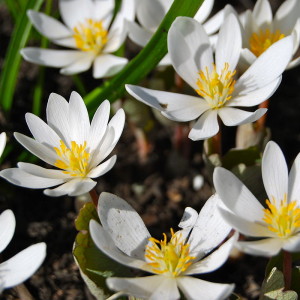Sanguinaria Canadensis is a perennial, herbaceous flowering plant native to eastern North America.
Contents
Uses
- Bloodroot was used historically by Native Americans for curative properties as an emetic, respiratory aid, and other treatments
- Bloodroot extracts have also been promoted by some supplement companies as a treatment or cure for cancer, but the U.S. Food and Drug Administration has listed some of these products among its “187 Fake Cancer ‘Cures’ Consumers Should Avoid”. Indeed, far from curing cancer, products containing bloodroot are strongly associated with the development of oral leukoplakia, which is a premalignant lesion that may develop into oral cancer.
- Commercial uses of sanguinarine and bloodroot extract include dental hygiene products. The United States FDA has approved the inclusion of sanguinarine in toothpastes as an antibacterial or anti-plaque agent
- Bloodroot is a popular red natural dye used by Native American artists, especially among southeastern rivercane basketmakers
Benefits
- Bloodroot is used to cause vomiting, empty the bowels, and reduce tooth pain. It is also used to treat croup, hoarseness (laryngitis), sore throat (pharyngitis), poor circulation in the surface blood vessels, nasal polyps, achy joints and muscles (rheumatism), warts, and fever.
- Some people apply bloodroot directly to the skin around wounds to remove dead tissue and promote healing. During the mid-1800s, bloodroot extracts were applied to the skin as part of the Fell Technique for treatment of breast tumors.
- In dentistry, bloodroot is used on the teeth to reduce the build-up of plaque. Plaque is a film of saliva, mucus, bacteria, and food particles that can promote gum disease.
Cautions
Interactions
- Currently there is no information about Interactions with Sanguinaria canadensis
Other names
Blood Root, Bloodwort, Coon Root, Indian Plant, Indian Red Paint, Pauson, Red Indian Paint, Red Puccoon, Red Root, Sang-Dragon, Sang de Dragon, Sanguinaire, Sanguinaire du Canada, Sanguinaria, Sanguinaria canadensis, Snakebite, Sweet Slumber, Tetterwort
References
Source:
Wikipedia, https://en.wikipedia.org/wiki/Sanguinaria
Picture credit: “Bloodroot (Sanguinaria canadensis)” by UpstateNYer – Own work. Licensed under CC BY-SA 3.0 via Commons – https://commons.wikimedia.org/wiki/File:Bloodroot_(Sanguinaria_canadensis).jpeg#/media/File:Bloodroot_(Sanguinaria_canadensis).jpeg

